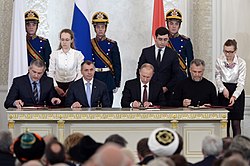Overview

- In Moldova: Transnistria (1), since 1992
- In Georgia: Abkhazia (2) and South Ossetia (3), since 2008
- In Ukraine: Crimea (4) and parts of Luhansk Oblast (5) and Donetsk Oblast (6), since 2014; and parts of Zaporizhzhia Oblast (7) and Kherson Oblast (8), since 2022
| Territory in question | Transnistria | Abkhazia | South Ossetia | Crimea and Sevastopol | Donetsk, Kherson, Luhansk and Zaporizhzhia |
|---|---|---|---|---|---|
| Claimed by | (1992–present) | (1992–present) | (2014–present) | (2022–present) | |
| De facto administrated by | (1992–present) | (1992–present) | (1992–present) | (2014–present) | (2022–present) active war zone |
| Russia considers it part of its territory? | No, Russia officially recognizes Moldovan sovereignty over Transnistria, following the Transnistria War [1] [2] | No, Russia recognises Abkhazia as an independent state [3] [4] since 2008 following the Russo-Georgian War | No, Russia recognises South Ossetia as an independent state [5] [6] since 2008 following the Russo-Georgian War | Yes, annexed in 2014 as federal subjects of Republic of Crimea and Sevastopol, following the start of Russo-Ukrainian War | Yes, annexed in 2022 as federal subjects of Donetsk People's Republic, Luhansk People's Republic, Kherson Oblast and Zaporozhye Oblast, following the 2022 invasion of Ukraine |
| Nature of occupation | Presence of the Operational Group of Russian Forces, opposed by Moldova | Presence of the 7th Military Base, opposed by Georgia | Presence of the 4th Guards Military Base, opposed by Georgia | Russian annexation not recognised internationally. Considered by Ukraine as "temporarily occupied territories" [7] | |
| De facto armed forces | Armed Forces of Transnistria | Abkhazian Armed Forces | Armed Forces of South Ossetia | Russian Armed Forces | active war zone |
| De facto circulating currency | Transnistrian ruble | Russian ruble | Russian ruble and Ukrainian hryvnia [8] [9] [10] | ||
| Passports | Transnistrian passport. Residents are also eligible for Moldovan or Russian passports for travel abroad. [11] | Abkhazian passport. Residents are also eligible for Russian passports for travel abroad. | South Ossetian passport. Residents are also eligible for Russian passports for travel abroad. [12] | Russian passport | Ukrainian passport being replaced by Russian passport [13] [14] |
| Under Russian telephone numbering plan? | No, +373 | Yes, +7 (840) and +7 (940) | Yes, +7 (850) and +7 (929) | Yes, +7 (978), +7 (365) and +7 (869) | Yes, +7 (856), +7 (857), +7 (860) and +7 (810) |




